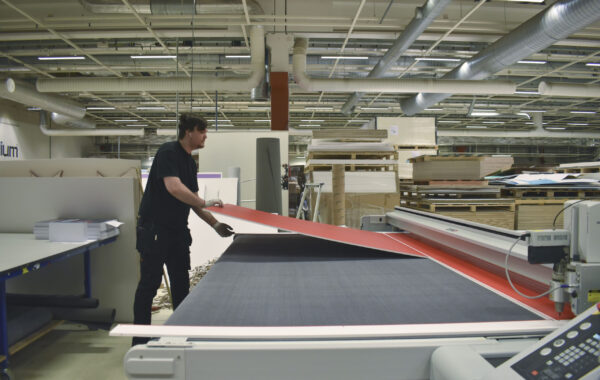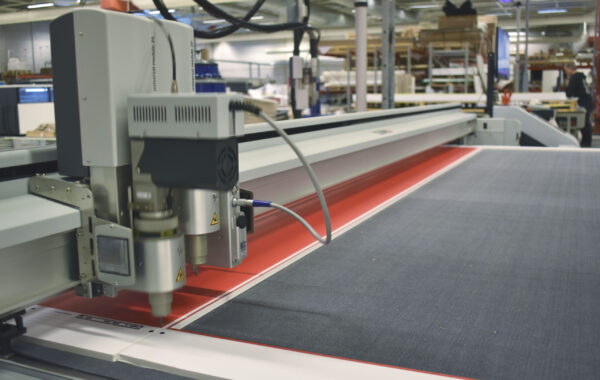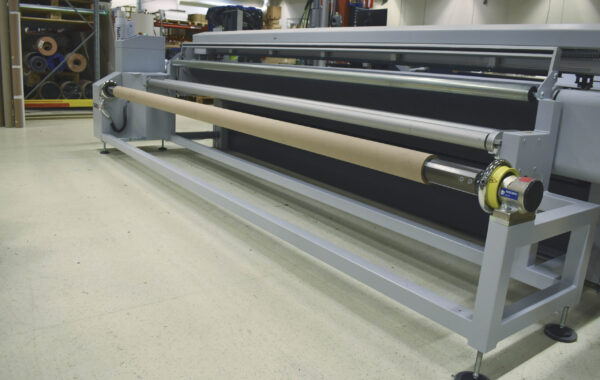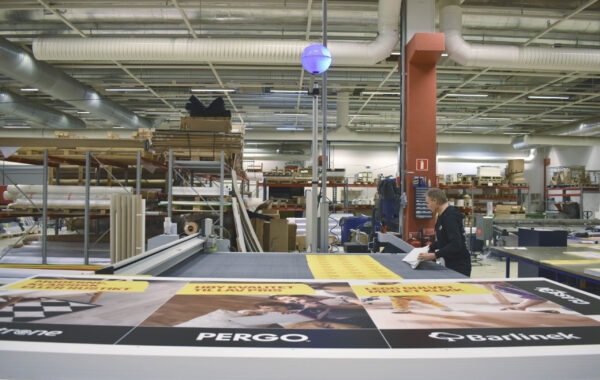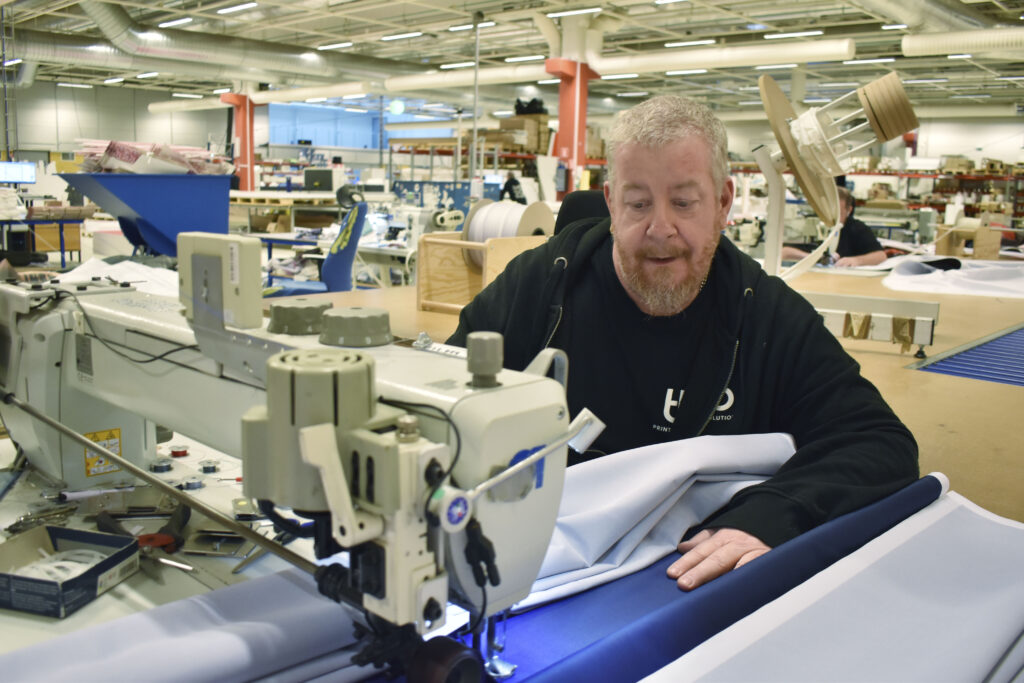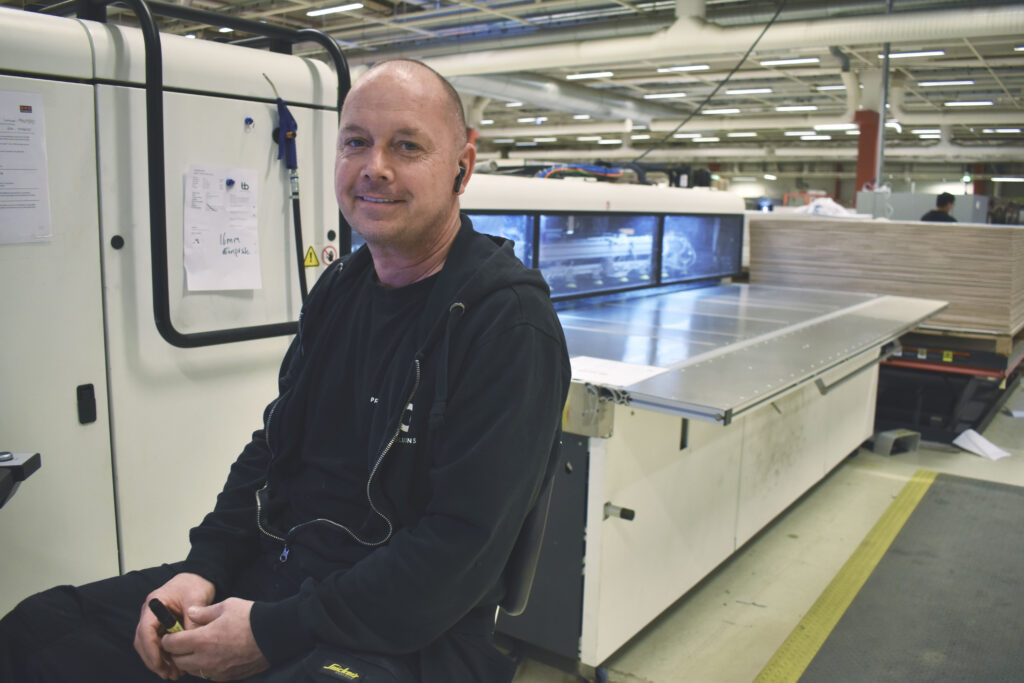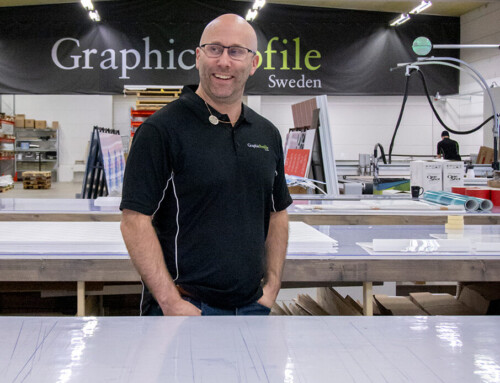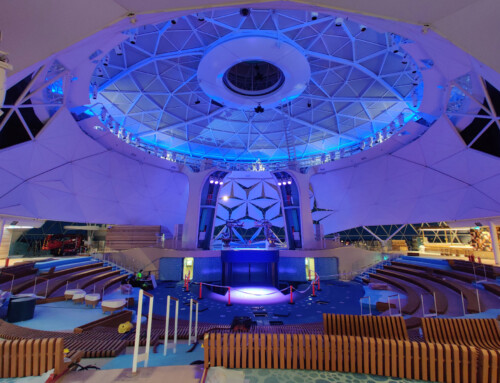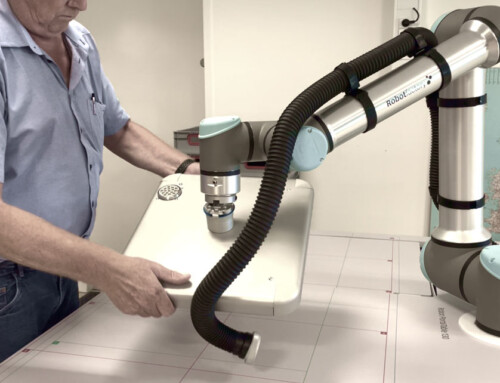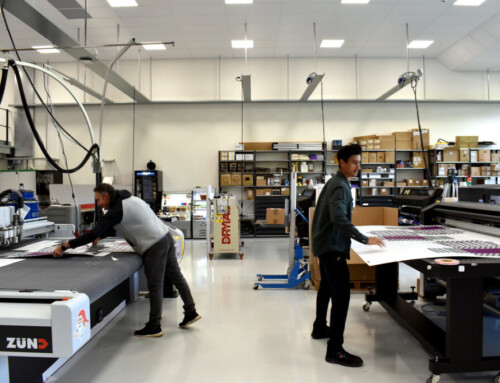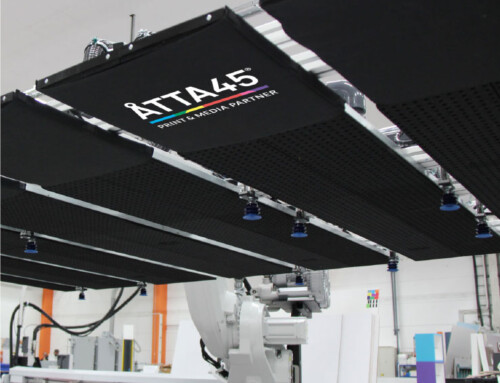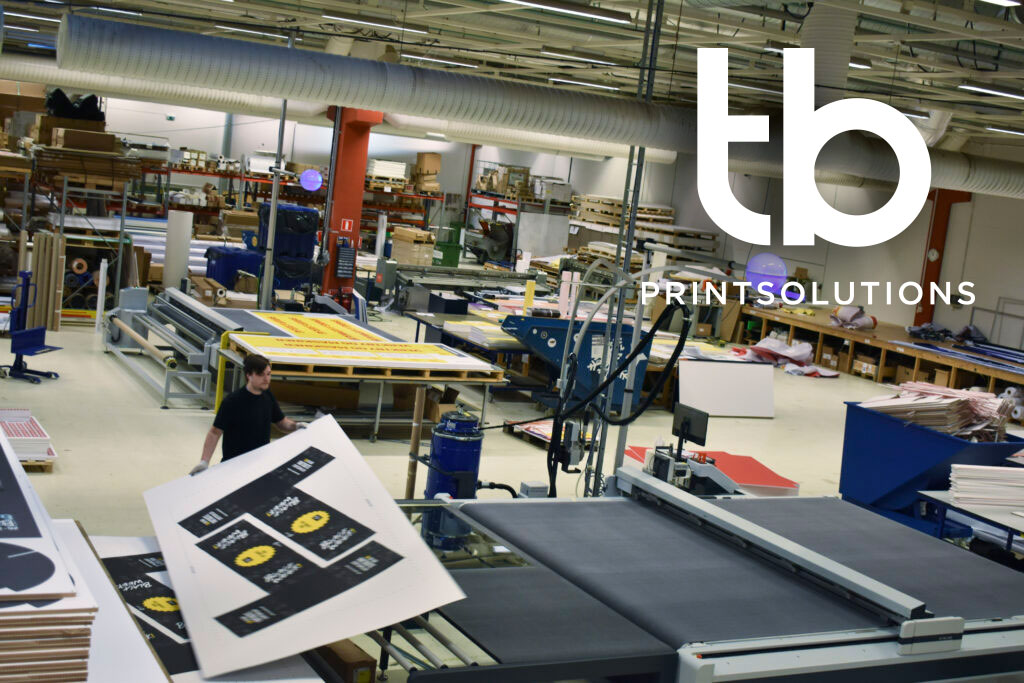
TB Printsolutions has streamlined cutting of fabric and media.
Photo: Claes Nordström
This case story is based on an article from SignPrint.se
TB Printsolutions in Västerås, Sweden cuts fabric, sheets and boards like never before in their production. Two optimized digital cutters from Zünd now run side by side in full width.
In round numbers, approximately 60% of materials that are printed and cut at TB Printsolutions are sheets and boards. 40% are fabrics.
– We mainly service retail customers and produce materials for a lot of campaigns, production manager, Magnus Eriksson, explains. When Sign & Print visits the printing company, the production is in a bustle.
There is a lot of catching up to do in the months before Christmas. To speed up the finishing processes, the Västerås company has invested in a new digital G3 3XL-2500 cutter from Zünd. At the same time, they have upgraded their existing G3 cutter to be more automated for cutting fabrics.
– Now we have two full width cutters that can process 3.2 meters, he says and adds that they had great confidence in Henrik Larsson Hedblom from Zünd Scandinavia who has assisted with support and help.
Tension control of fabrics
The existing cutter has been upgraded with Zünd’s camera technology Eye in The Sky to provide a greater efficiency in fabric cutting. The system automatically identifies next job and starts cutting.
Magnus Eriksson explains that all the operator now must do, is to mount the fabric roll, press the start button to get started. They have also acquired a motorized roll-off unit with tension control for feeding fabrics
– We have installed a Center Winder roll-off unit that allows the fabric to stretch, which gives a greater precision in cutting. Before the cutter upgrade, it was a passive roll-off unit.
– The advantage of cutting fabrics is the fast production speed, due to the continuous automated roll-feed. Very quickly, you can process 100 meters without having to pause the production. Sheets and boards on the other hand, must be loaded and unloaded. However, there are many other steps to consider when working with fabric, Mikael Eriksson points out. To start with, the fabric must pass through a printer from one roll to another. A printer head travels back and forth to apply ink, which causes the fabric to become hot and sometimes shrink or stretch. Some textiles have more cotton fibers than others, which means that they behave differently. Therefore, the Center Winder unit becomes an important part of cutting successfully.
– When cutting, the fabric is secured to the table with vacuum. Without something to control the feeding and stretching of the fabric, you risk having inaccuracy in the cutting. Being able to cut fabric with precision is very important. For example for light boxes with sewn-in rubber strips. If the cut is inaccurate, the fabric will hang incorrectly and become too sloppy or tight.
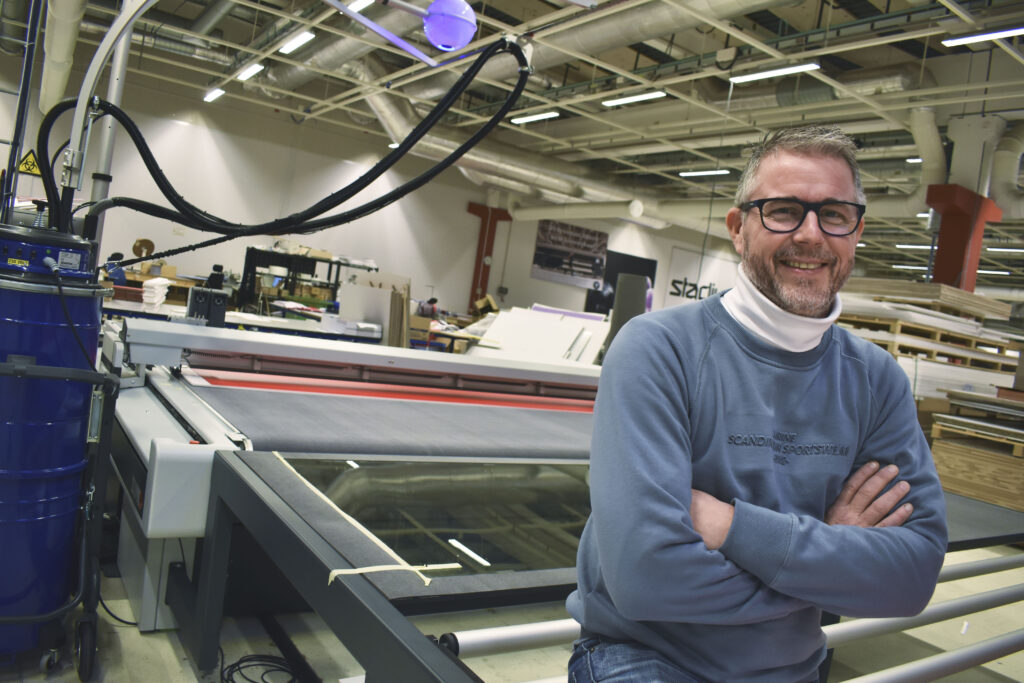
Magnus Eriksson, Production Manager at TB Printsolutions in Västerås, sees an increased capacity in the cutting of fabric and other media.
Photo: Claes Nordström
Backside cutting made easy
On the new cutter, where the sheets and boards are processed, the cutter has not only camera registration from above, but also from below. Backside cutting is made possible with Zünd EIS Load Table.
Although most jobs are printed and cut from the print side, special solutions and construction jobs on thick sandwich cardboard based materials from Swedboard, often have to be cut from the opposite side of the print.
– Earlier, the operator had to load the sheet, cut out the registration marks – then turn the sheet and cut from the back. For instance, if you want to cut a box from thick material, you need to make v-cuts on the side that is not printed. This means that the operator must lift and turn every item by hand, which takes really long time. Now we can cut the whole board at once. The EIS Load Table reads the registration marks, makes the measurements, feeds the board forward to the correct position and starts cutting on the backside of the board.
We save an extremely large amount of time on this, and save the operators from too many lifts.
There is no doubt that we have increased our capacity in the finishing of jobs. The exact amount of time saved, they have not yet had time to calculate:
– Right now we are extremely busy, so we haven’t had time to register how much faster the production has become, but the operator doesn’t have to stand and check every file to see if every number is correct – the camera does the job.
– Our capacity has increased with at least 25% with Eye in The Sky, which means that we don’t have to load so often. The setup time on the cutter has become faster, and the risks of errors are minimized.
– It’s a completely different setup that makes cutting safer and faster. Another advantage is less wear and tear. When choosing a material, the setup must be correct, so the operator doesn’t have to make unnecessary adjustments. The cutter chooses the knife itself according to the material and material thickness, so our production has become much more automated and thus more efficient.
Picking and cutting simultaneously
To increase the efficiency of the new cutter, TB Printsolutions have invested in an extension table. Once the sheet or board has been cut, it is conveyed to the extension table, making room for the next sheet on the cutter. The operator can unload the finished job without having to pause the production.
– This has formerly stolen a lot of time. Now we have room on the table to do more things at the same time.
– It goes without saying, that the cutter is much more efficient when it has the knife to the table. Not when it’s waiting for the next job to be loaded!
When asked if there are plans to install robots for loading, unloading and picking, they are considering.
– We are open to all possibilities – also for our printers, but nothing is fixed on yet. We want to feel 100% at home in our current setup first.
Back to 2019 levels
TB Printsolutions had sales of just over SEK 80 million in the recent financial status. Magnus Eriksson explains that they had a considerable loss in May and June due to the pandemic, whereafter they adjusted the production to ”different things”
– We started cutting aprons for healthcare and dividers for store cash registers. This made it able for us to turn the production up again. We tried to be innovative so that we cut two aprons in each insert. We rebuilt so we could feed two rolls on top of each other at the same time, so to double the layers and outcome.
– It wasn’t that we were making so much money, but we were able to keep production up and our staff employed. We worked in three shifts solely on the aprons. This kept the whole machinery running, and we didn’t have to worry about layoffs. I think this was a valuable morale-boost for the whole company.
He says that they are satisfied with 2020 given the circumstances.
– We have managed to stay comfortably afloat. We lost just over 18 percent in sales last year compared with the year before. Now in 2021 we are looking at the same numbers as in 2019. We have also obtained new skills and experiences with different things.
However, he emphasizes that it has been obtained by hard work. It’s rarely just about luck, when it comes to getting orders.
Build our own workflow
In order to keep the production efficient with as little manual interference as possible, developing automation is the main focus.
– We are very much in favor of building our own workflows, and tweaking them so they become as efficient as possible. To mix customer jobs, and combine them with automation so they work effortlessly all the way – this is what excites us most.
Magnus Eriksson says they as a company always strive after being in the very front. The latest investments in new machines are a testament to this.
– We also have an owner who is not afraid of investing, which is really cool. We try to be in the absolute top with our machine park – so we are always in a position to make money.

